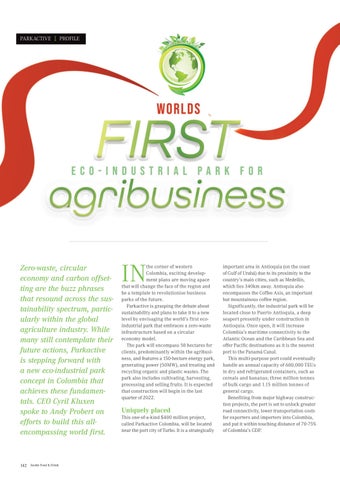PARKACTIVE
I
PROFILE
Zero-waste, circular economy and carbon offsetting are the buzz phrases that resound across the sustainability spectrum, particularly within the global agriculture industry. While many still contemplate their future actions, Parkactive is stepping forward with a new eco-industrial park concept in Colombia that achieves these fundamentals. CEO Cyril Kluxen spoke to Andy Probert on efforts to build this allencompassing world first.
142
Inside Food & Drink
IN
the corner of western Colombia, exciting development plans are moving apace that will change the face of the region and be a template to revolutionise business parks of the future. Parkactive is grasping the debate about sustainability and plans to take it to a new level by envisaging the world’s first ecoindustrial park that embraces a zero-waste infrastructure based on a circular economy model. The park will encompass 50 hectares for clients, predominantly within the agribusiness, and features a 150-hectare energy park, generating power (50MW), and treating and recycling organic and plastic wastes. The park also includes cultivating, harvesting, processing and selling fruits. It is expected that construction will begin in the last quarter of 2022.
Uniquely placed This one-of-a-kind $400 million project, called Parkactive Colombia, will be located near the port city of Turbo. It is a strategically
important area in Antioquia (on the coast of Gulf of Urabá) due to its proximity to the country’s main cities, such as Medellín, which lies 340km away. Antioquia also encompasses the Coffee Axis, an important but mountainous coffee region. Significantly, the industrial park will be located close to Puerto Antioquia, a deep seaport presently under construction in Antioquia. Once open, it will increase Colombia’s maritime connectivity to the Atlantic Ocean and the Caribbean Sea and offer Pacific destinations as it is the nearest port to the Panamá Canal. This multi-purpose port could eventually handle an annual capacity of 600,000 TEUs in dry and refrigerated containers, such as cereals and bananas; three million tonnes of bulk cargo and 1.15 million tonnes of general cargo. Benefiting from major highway construction projects, the port is set to unlock greater road connectivity, lower transportation costs for exporters and importers into Colombia, and put it within touching distance of 70-75% of Colombia’s GDP.
